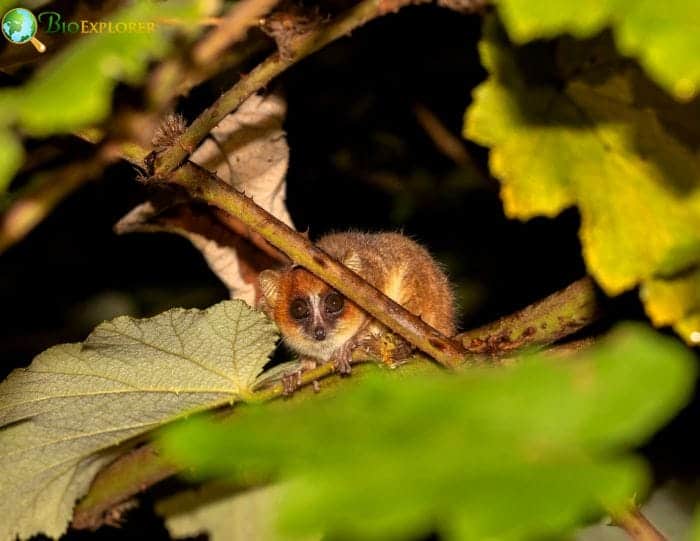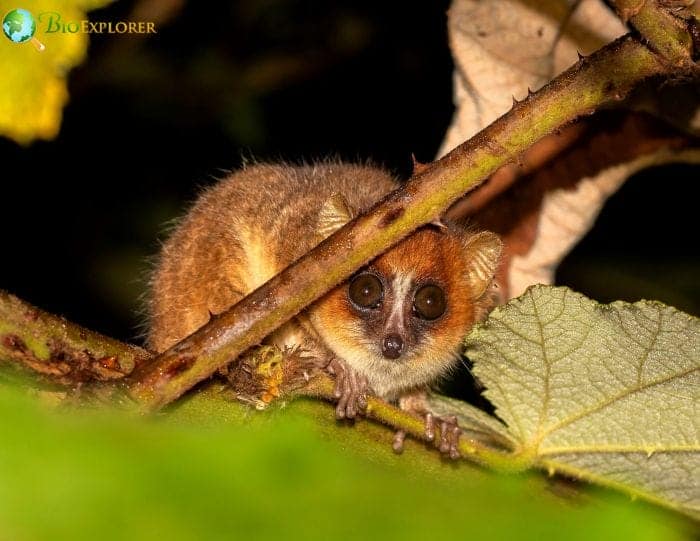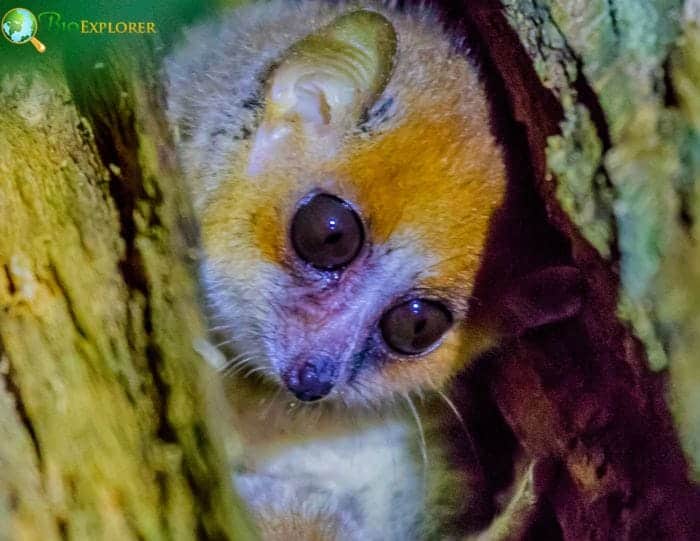
| Animalia | Mammalia | Primates | Cheirogaleidae | Chordata | Microcebus lehilahytsara |
Madagascar, an island teeming with mysteries of nature, presents yet another marvel that thrives under the cloak of night – the Goodman’s Mouse Lemur (Microcebus lehilahytsara). This pint-sized primate may be easy to miss. Still, it plays a giant role in the ecological tapestry of the island’s unique biodiversity.
Imagine a creature as light as a pack of cards, with eyes like glossy marbles, scurrying through the dense foliage in the moonlit forests of Madagascar. This is the Goodman’s Mouse Lemur, an elusive and enchanting species and a silent witness to the secrets of the nocturnal world.
Despite its diminutive size, the Goodman’s Mouse Lemur is a resilient survivor in the wild. Weighing barely less than 50 grams, it is a part of the microcebus genus known for being the smallest primates on Earth. But don’t let their size fool you; these lemurs are a big deal in the study of evolutionary biology and conservation.
Goodman’s Mouse Lemurs are not just another species but a crucial part of the Malagasy ecosystem. They play a significant role in seed dispersal and insect population control. Understanding them is key to unraveling the complexities of Madagascar’s rich biodiversity and ensuring that the intricate web of life continues to thrive on this unique island.
Table of Contents
- Goodman’s Mouse Lemur Characteristics
- Goodman’s Mouse Lemur Distribution
- Goodman’s Mouse Lemur: Surviving Madagascar’s Extremes
- Goodman’s Mouse Lemur’s Social Dynamics and Reproductive Rituals
- Goodman’s Mouse Lemur: A Keystone in Madagascar’s Biodiversity
- Fascinating Facts About Goodman’s Mouse Lemur
- Conclusion
Goodman’s Mouse Lemur Characteristics
Goodman’s mouse lemur[1] is a mouse lemur species from the Andasibe region in eastern Madagascar. Mouse lemurs are one of the smallest primates, and Goodman’s mouse lemur is no exception.
Although not the smallest overall, this species has a head-body length comparable to Microcebus berthae, the smallest known primate. The average size varies between 45 and 48 grams, with males slightly larger than females.
Goodman’s mouse lemur is mostly brown with a white underpart and an orange tint on its back. These lemurs go through daily torpor and winter inactivity. Their tails can store fat, which helps prepare for winter torpor.
![]()
Goodman’s Mouse Lemur Distribution
Goodman’s Mouse Lemur: Surviving Madagascar’s Extremes

The Goodman’s Mouse Lemur, a denizen of Madagascar’s varied landscapes, has mastered the art of survival through a remarkable physiological adaptation known as heterothermy. This section delves into the lemur’s use of torpor and hibernation as survival strategies in the challenging environment of central Madagascar’s high-plateau forest, particularly in Ankafobe.
Hibernation: The Winter Strategy of Goodman’s Mouse Lemur
During the cooler months, when resources become scarce, Goodman’s Mouse Lemur retreats into a state of hibernation.
- This energy conservation tactic has been observed in the high-altitude forest fragments of Ankafobe.
- These mouse lemurs effectively navigate the harsh climatic conditions by descending into a lethargic state within the natural insulation of tree holes.
- This behavior underscores the critical role of specific habitat features, like tree holes, which offer a stable environment against the potentially extreme ambient temperatures of the high plateau.
![]()
Torpor: Daily Energy Savings
Beyond the seasonal hibernation, the Goodman’s Mouse Lemur also exhibits daily torpor.
- This shorter, temporary drop-in metabolic rate allows them to conserve energy.
- This strategy is particularly beneficial in the unpredictable environment of Madagascar, where daily fluctuations in temperature and food availability can pose a challenge to the survival of this tiny primate[2].
![]()
Implications for Conservation
Understanding the Goodman’s Mouse Lemur’s reliance on hibernation and torpor sheds light on their intricate survival mechanisms.
- It signals the importance of preserving their natural habitats. As climate change and deforestation pose increasing threats, the need for conservation efforts becomes more urgent.
- Protecting the forest fragments and the tree holes essential for the lemurs’ hibernation is not just about saving a species; it’s about maintaining the ecological balance of an entire region.
![]()
Goodman’s Mouse Lemur’s Social Dynamics and Reproductive Rituals
In the Goodman’s Mouse Lemur realm, social interactions are as intriguing as their survival tactics. Their society is a tapestry woven with solitary pursuits and occasional communal connections.
The Solitary and the Social: A Balancing Act
Goodman’s Mouse Lemurs are predominantly solitary creatures, especially when it comes to foraging.
- Males typically have larger territories than females, which could result from being pushed away from prime feeding areas by dominant females.
- Despite their solitary nature, they display social behaviors, such as group sleeping, which is believed to be for thermoregulation.
![]()
Battles and Brotherhood: The Complexity of Feeding
Regarding food, confrontations are common, with females often reigning victorious due to their dominance over males. This behavioral aspect emphasizes the matriarchal tendencies within their social structure, which is an intriguing facet of their overall behavior in the wild.
![]()
Mating: A Peaceful Interlude
Breeding presents a rare peaceful interlude in the otherwise solitary lives of these lemurs.
- After emerging from their winter slumber, mating season commences. Males are equipped with large testes, hinting at sperm competition as opposed to direct conflict over mates.
- This strategy minimizes aggressive encounters and emphasizes the importance of genetic diversity.
![]()
Conservation Considerations
Understanding the social structure and breeding patterns of Goodman’s Mouse Lemur is crucial for developing effective conservation strategies. Protecting their habitats ensures their survival and the preservation of their complex social behaviors, which are vital for the continuation of the species.
![]()
Goodman’s Mouse Lemur: A Keystone in Madagascar’s Biodiversity
In the rich tapestry of Madagascar’s ecosystems, the Goodman’s Mouse Lemur plays a crucial role, making its conservation a matter of ecological significance.
The Ecological Role of Goodman’s Mouse Lemur
Goodman’s Mouse Lemurs, through their varied diet, contribute to seed dispersal and insect population control. This makes them vital players in maintaining the ecological balance. Their survival and thriving are indicators of forest health and biodiversity.
![]()
Facing the Challenges: Threats to Survival
The survival of Goodman’s Mouse Lemurs is threatened by deforestation, climate change, and habitat fragmentation. These factors endanger the lemurs and disrupt the delicate balance of the entire ecosystem. Conservation efforts must address these challenges to ensure the lemurs’ survival and the myriad species that share their habitat.
![]()
Conservation Efforts: A Ray of Hope
Efforts to conserve Goodman’s Mouse Lemurs involve habitat protection, reforestation, and research. Understanding their behavior and habitat requirements is crucial for effective conservation strategies. Supporting local and international conservation initiatives is key to ensuring a future for these unique primates.
![]()
The Bigger Picture: Goodman’s Mouse Lemur and Global Biodiversity
The conservation of Goodman’s Mouse Lemur extends beyond Madagascar. It represents a global effort to preserve biodiversity. Every species plays a unique role in its ecosystem, and the loss of one can have cascading effects. Preserving Goodman’s Mouse Lemur is a step towards maintaining the global ecological balance.
![]()
Fascinating Facts About Goodman’s Mouse Lemur

- One of the Smallest Primates: Despite not being the absolute smallest, Goodman’s Mouse Lemur ranks among the tiniest primates. Their size ranges from 45-48 grams, comparable to Madame Berthe’s mouse lemur, the smallest known primates.
- Unique Hibernation Habitats: These lemurs use tree holes for hibernation, which protect them from extreme temperatures. This adaptation is vital for their survival during the harsh winters in Madagascar’s high plateau regions.
- Matriarchal Dominance: In the Goodman’s Mouse Lemurs world, females reign supreme, especially regarding food. They often win confrontations over food against males, showcasing their dominance in the species’ social structure.
- Name Significance: Their scientific name, Microcebus lehilahytsara, honors primatologist Steven M. Goodman[3]. “Lehilahytsara” combines Malagasy words meaning “good” and “man, ” reflecting both cultural and scientific significance.
- Ancient Lineage: The genus Microcebus, to which Goodman’s Mouse Lemurs belong, is believed to have diverged around 10 to 9 million years ago, highlighting their ancient evolutionary history.
- Diet Diversity: Goodman’s Mouse Lemurs have a varied diet, including insects, fruits, flowers, nectar, gum, and leaves. This dietary flexibility helps them adapt to different environmental conditions.
- Tail as a Fat Reserve: Their tails serve as fat reservoirs, an essential adaptation for storing energy in preparation for winter torpor. This biological feature is key to their survival strategy during food-scarce periods.
- Gender Differences in Torpor: While almost all females undergo winter torpor, not all males do. Older males often skip this period to gain a mating advantage, as they’re better competitors against younger males.
- Sperm Competition: During mating[4], instead of engaging in physical battles, Goodman’s Mouse Lemurs engage in sperm competition. This strategy reduces aggressive encounters and promotes genetic diversity.
- Solitary Yet Social: Primarily solitary, they do exhibit social behaviors like communal sleeping for warmth, and females often share sleeping spaces with their kin, emphasizing their complex social interactions. Often, groups of 2 to 4 lemurs of the same sex come together to sleep. This is possibly to conserve heat.
Conclusion
As we conclude our journey through the fascinating life of the Goodman’s Mouse Lemur, it’s clear that this tiny primate is a marvel of Madagascar’s biodiversity. From their unique survival strategies like hibernation and torpor to their complex social structures and significant ecological roles, Goodman’s Mouse Lemurs are a testament to the intricate web of life on the island.
Goodman’s Mouse Lemurs not only contribute to the ecological balance of Madagascar but also offer invaluable insights into primate evolution and behavior. Their existence highlights the importance of conservation efforts in preserving a species and an entire ecosystem.
By understanding and appreciating these tiny creatures, we can better advocate for their protection and the preservation of their habitats. Supporting conservation initiatives and spreading awareness are crucial steps towards ensuring a future for Goodman’s Mouse Lemurs and the diverse wildlife of Madagascar.
Every species, no matter how small, plays a vital role in the health and diversity of our planet. The story of Goodman’s Mouse Lemur reminds us of our responsibility to protect these delicate natural systems for future generations.
![]()










